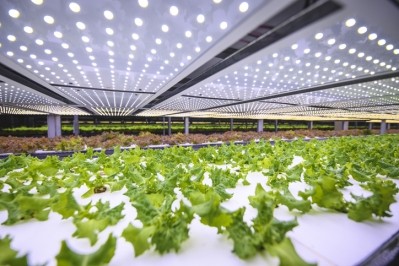Rootwave CEO: ‘Autonomous tech breeds reliability and farmer confidence’

RootWave’s technology applies an electrical current to weeds, causing their roots to heat up and die.
It is attached to the back of a tractor. As the tractor drives between crops, metal contacts on the system ‘zap’ any weeds growing near vines or trees.
RootWave's technology is designed to provide a sustainable and economical solution to help organizations manage weeds without chemicals.
It technology is currently being used by English Heritage at the Organic Kitchen Garden at Audley End House & Gardens, and is being pioneered by farmers in Wales in an European Innovation Partnership Wales project.
Last month, it announced a partnership with Garford Farm Machinery, the UK manufacturer of technologically advanced mechanical weed control products.
This will see the two manufacturers co-develop new weeding technology and products, integrating electrical weeding into precision guided toolbar systems, for high-value and high-intensive crops as well as broadacre arable applications.
RootWave CEO Andrew Diprose said, “Combining forces with Garford allows us to create a formidable solution for the industry, combining best-in-class power electronics, imaging and artificial intelligence to create an unrivalled weed control solution for vegetables, cereals and row-crops.
“It will alleviate the worries of farmers who are faced with an uncertain future where they don’t know if herbicides will be available or will even be effective due to safety and resistance issues.”
Garford Managing Director Jonathan Henry said: “With the increasingly stringent controls over the use of chemical weed management, alongside resistance issues, we can support UK and global agriculture as it embraces its environmental responsibilities.
“Combining our technologically advanced precision guided weed control solutions, with the benefits of RootWave’s high frequency alternating current electrical weeding technology, we can create commercially viable and effective solutions to growers, as a key part of a sustainable, integrated weed management system.”
In light of the partnership, we asked RootWave’s CEO some more questions about the tech.
ATN: How does RootWave's electric weed control technology compare to traditional chemical herbicides in terms of efficacy and long-term weed management?
AD: RootWave’s eWeeding technology is a chemical-free method of killing all weeds and their roots, it’s physics not chemistry. Electricity is systemic by action, flowing into the target weed generating heat in both the weed and root, killing it instantly. All weeds are susceptible to electricity and unlike chemical herbicides weeds cannot evolve resistance to electricity meaning eWeeding is a thousand-year solution.
ATN: What are the environmental benefits of using RootWave's technology compared to conventional weed control methods?
AD: RootWave eWeeding is friendly to soils, independent soil heath analysis shows that RootWave eWeeding is safe to both micro and macrofauna including earthworms. Unlike chemical herbicides RootWave eWeeding doesn’t leave chemical residues in the soil and unlike mechanical weeding eWeeding it doesn’t disturb the soil. eWeeding allows the soil to heal and capture more carbon.
ATN: Can you explain the safety features of RootWave's high-frequency AC technology and how it differs from other electric weed control systems?
AD:RootWave eWeeding operates high-frequency (18,000 Hz and above) AC which is orders of magnitude safer than other electric weed control technologies on the market that use 50-60 Hz AC or DC.
ATN: What challenges has RootWave faced in scaling up its technology from handheld devices to tractor-powered machines for larger agricultural applications?
AD:When researching the orchard and vineyard markets it was soon apparent that there were multiple layouts and dimensions of growing systems, we visited one top-fruit farm that had 5 different row widths across their farm. Entering a market where production efficiency is critical, it was important that we designed the eWeeder so it could be used to treat weeds in multiple orchard types and layouts to enable farmers to fully utilise the machine. As a result, we have designed a machine that can be used on orchards and vineyards with row widths ranging 1.8 m to 4.5 m, treating at forward speeds up to 5km/h across different terrains and surfaces.
ATN: How does the cost-effectiveness of RootWave's system compare to traditional herbicide use over time, considering the initial investment and ongoing operational costs?
AD:Our market research told us that when purchasing new equipment or changing input strategy farmers are interested in the Total Cost per Hectare (TCPH). When purchasing a RootWave eWeeder the farmer has made a choice between purchasing new conventional equipment (e.g. a herbicide sprayer) or new eWeeding equipment. The total cost per hectare considers the depreciation of equipment, the consumable cost (herbicide concentrate, fuel) and the labour cost. Our analysis shows that eWeeding has a lower TCPH than herbicides for farm sizes exceeding 80 hectares. When including available grants for eWeeding (for example, the £50k farming equipment grant and £101/Ha farmer payment schemes in UK with similar grants available in other countries) eWeeding has a lower TCPH for farm sizes exceeding 50 hectares.
ATN: What types of crops or agricultural settings are best suited for RootWave's technology, and are there any limitations to its use?
AD:RootWave eWeeding technology is developed for use in tree fruit, vineyards, and bush fruit. From a mechanical design perspective these applications are well suited for eWeeding as they are permanent structures that have known treatment parameters for the effective and accurate placement of the treatment electrodes. eWeeding will be further developed into precision planted vegetables and row crops, the power electronics are fully developed for use in most weed control situations, but will need synergy with precision application technology to maximise efficiency in broadacre arable.
ATN: How does RootWave's technology perform in different soil types and weather conditions?
AD:RootWave has conducted trials in Europe on a range of soil types, soil moistures and weather conditions. Usage and trial data indicates excellent levels of weed control in a range of conditions. Typically, if the field is dry enough for a tractor to travel then we would expect to achieve very good performance. The window to use eWeeding is significantly larger than herbicides and mechanical weeding, eWeeding can be used in a range of condition, in windy weather, near water and in sensitive areas. conditions and cold conditions. As with other methods the speed of effect is more apparent in warmer temperatures when weeds are actively growing.

ATN: What feedback have you received from farmers and other users who have adopted RootWave's technology?
AD:The first farmer purchased machines will be arriving on farm in Autumn 2024. We have received very positive feedback from growers who have had first hand demonstrations and trials on their farms. They have told us how impressed they are with the speed of weed kill, the precise nature of application and how productive they can be with the large use window. All farmers emphasise great value in the fact that RootWave eWeeding is soil friendly.
ATN: How is RootWave addressing potential concerns about the impact of electrical weed control on soil microorganisms and beneficial insects?
AD:Independent analysis of hundreds of soil samples taken from trials over multiple years indicate eWeeding to be safe to soil life. No negative effects to from eWeeding to soil life have been observed or measured on any soil dwelling organisms including fungi, bacteria and beneficial insects. Soil health is an important topic and RootWave will continue to monitor the benefits to soil health as eWeeding becomes widely adopted.
ATN: What are RootWave's plans for expanding its product range or adapting its technology for other agricultural applications?
AD:RootWave eWeeding technology is developed for use in tree fruit, vineyards, and bush fruit. In June, 2024 RootWave and Garford Farm Machinery announced a partnership to develop new eWeeding technologies and products for use in broadacre arable and vegetable crop applications.
ATN: How does RootWave's technology fit into the broader trend of sustainable farming practices?
AD:RootWave eWeeding is compatible with the principles of sustainable farming; it’s chemical free, soil friendly, and it controls all weeds. Unlike herbicides eWeeding doesn’t have the negative side effects of leaving residues in the environment and food. It is a cost effective weed control tool that will be used with great success for generations without the fear of herbicide resistance.
ATN: What regulatory challenges does RootWave face in different markets, and how is the company navigating these?
AD:eWeeding is generally regulated under safety, health, or environmental regulations. For example, CE marking (European Conformity) and UKCA (UK Conformity Assessed) for Europe and the UK respectively. Our regulatory strategy is aligned to the commercial rollout.
ATN: How do you envision the future of farming with increased adoption of autonomous technology? What’s key to ensuring user adoption?
AD:The adoption of autonomous technology will be directly correlated to increased productivity, the availability and cost of labour and quality improvement. The certainty of reliability that autonomous technology brings allows famers to plan with greater confidence on cost and productivity. Key to farmer adoption is ROI timescale, the ease of integration into existing production systems and proven reliability.


















